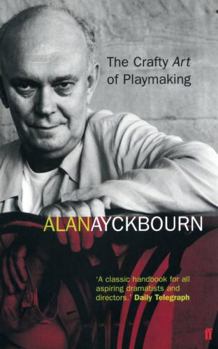The Crafty Art of Playmaking
Select Format
Select Condition 
Book Overview
For the first time, Alan Ayckbourn shares all of his tricks of the playwright's trade. From helpful hints on writing to tips on directing, the book provides a complete primer for the newcomer and a... This description may be from another edition of this product.
Format:Paperback
Language:English
ISBN:0571215106
ISBN13:9780571215102
Release Date:January 2004
Publisher:Faber & Faber
Length:173 Pages
Weight:0.50 lbs.
Customer Reviews
3 ratings
Text for Plays
Published by Thriftbooks.com User , 14 years ago
I purchased this for a screenwriting course and it was pretty good. I'm no playwright but this was a text that was both valuable in terms of the amount of information but also in it's transmission of said information; it was an easy and enjoyable read.
Perhaps the best book ever about playwriting and directing
Published by Thriftbooks.com User , 18 years ago
There are dozens of books out there on playwriting and about half that number on directing. Unfortunately for us, neither Shakespeare, Chekhov nor Ibsen wrote books on how to write a play. As a result, virtually all the authors of books about playwriting are academics who have never written a commercially produced play. One has to question the value of such people's advice when dealing with the practical realities of the professional theatre. Sir Alan Ayckbourn has changed all that. He is the author/director of (at this writing) a whopping 69 plays, a substantial portion of which have been critical and/or commercial successes on London's West End and New York's Broadway as well as being translated into numerous languages and produced throughout the world. The first part of the book is about the craft of playwriting. Ayckbourn gives his advice in a straightforward series of "obvious rules." First he states the "obvious rule" and then illustrates it with an example, usually drawn from his own work. Some of my favorites were, "Obvious Rule No. 2: Never start a play without an idea." "Obvious Rule of No. 16: Never include a character with no real function." "Obvious Rule Number 14: At least 50 percent of your play is going to be visual." "Obvious Rule No. 22: You can never know too much about your characters before you start." Ayckbourn says that he takes about a year of thinking and planning before he actually writes a word of dialogue. I found this section of the book extremely valuable. Any playwright or would-be playwright would profit from reading it. To my surprise, I found the second part of the book, which deals with direction, even more valuable than the first part. Aside from Harold Clurman's ON DIRECTING, I cannot think of another book about directing that has been written by a successful director. Clurman's book is very good about reading a script and analyzing it and giving an overall view of how rehearsals are conducted. Most books on directing provide this information. But what sets Ayckbourn's book apart is that he talks mostly about dealing with actors. To the best of my knowledge, no one has written about this aspect. He tells how to handle fragile egos, how to deal with rivalries, how to state your criticism and the appropriate times to deal with certain issues. He also gives good advice on conducting auditions and what personality traits to look for when casting. Advice like this has long been needed. The book provides valuable information, but what makes it truly brilliant is the charming way it is written. I found it delightful from start to finish, not to mention inspirational. I cannot recommend this book highly enough to any theatre professional, not just writers and directors, but actors, designers and technicians as well. Five stars plus.
More Than Just Playmaking
Published by Thriftbooks.com User , 19 years ago
Alan Ayckbourn's book on the art of the theater covers far more than just "playmaking" His years of experience as both author and director are evident as he gives "obvious rules" for writing, directing, establishing characters, and everthing in between.Not only does he devote a substantial amount of space to the play writing process, but he also talks about casting, lighting, chosing a costume designer, working with your tech staff, and dealing with your actors during the various stages of the production.All this is given, not as a dissertation, but with a genuine sense of love for his craft. I found the examples of dialogue-taken from his own plays to illustrate the various points of writing-extremely helpful.I will refer to this book again in my own writing endeavors.Highly recommended.





